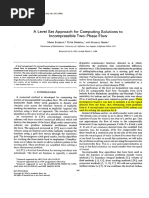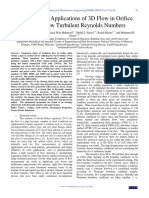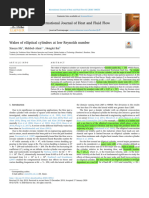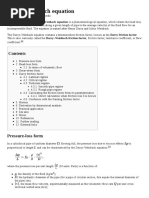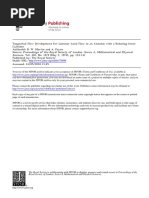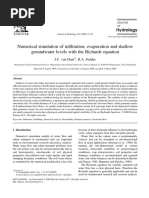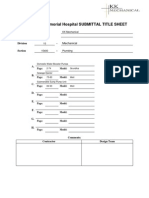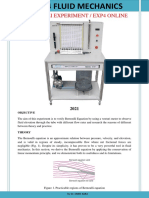Explicit Formulation of The Shields Diagram For Incipient Motion of Sediment
Explicit Formulation of The Shields Diagram For Incipient Motion of Sediment
Uploaded by
Jaya LoundriCopyright:
Available Formats
Explicit Formulation of The Shields Diagram For Incipient Motion of Sediment
Explicit Formulation of The Shields Diagram For Incipient Motion of Sediment
Uploaded by
Jaya LoundriOriginal Title
Copyright
Available Formats
Share this document
Did you find this document useful?
Is this content inappropriate?
Copyright:
Available Formats
Explicit Formulation of The Shields Diagram For Incipient Motion of Sediment
Explicit Formulation of The Shields Diagram For Incipient Motion of Sediment
Uploaded by
Jaya LoundriCopyright:
Available Formats
TECHNICAL NOTES
Explicit Formulation of the Shields Diagram for Incipient
Motion of Sediment
Zhixian Cao1; Gareth Pender2; and Jian Meng3
Abstract: The Shields diagram remains the most widely used criterion for incipient motion of sediment. However its implicit nature
makes applications rather inconvenient. By deploying Guo’s logarithmic matching method twice, this technical note develops an explicit
formulation of the Shields diagram, enabling the critical Shields parameter to be determined directly from fluid and sediment character-
istics without resorting to any trial and error procedure or iteration. An extended application of the logarithmic matching method is
demonstrated.
DOI: 10.1061/共ASCE兲0733-9429共2006兲132:10共1097兲
CE Database subject headings: Sediment transport; Shear stress; Hydraulics; Coastal environment.
Introduction number R* ⬅ du* / v, defined using u* that is yet to be determined.
For a specific set of fluid and sediment parameters, one has to
Sediment transport is a generally important process in fluvial and resort to some sort of trial and error procedure or iterations to find
coastal environments. One of the fundamental aspects of sediment the critical bed shear stress. This makes its application in river
transport is concerned with the critical condition for incipient and coastal engineering rather inconvenient.
motion of sediment. To date there have been a large number of A closer scrutiny of the Shields diagram 共in a log–log illustra-
experimental studies on this topic, as delineated not only in tra- tion兲 shows that the critical Shields parameter c follows distinct
ditional monographs and textbooks 共Graf 1971; Raudkivi 1976; distributions with the shear Reynolds number R* 共Graf 1971;
Zhang and Xie 1990; Yang 1996; Chien and Wan 1999; Yalin Raudkivi 1976; Yang 1996; Chien and Wan 1999; Yalin and da
and da Silva 2001兲, but also in current papers 共Buffington and Silva 2001兲. In particular, c declines with increasing R* follow-
Montgomery 1997; Buffington 1999; Shvidchenko and Pender ing a declining straight line in the lower region as R* is smaller
2000兲. than around 2, c is constant while R* is sufficiently large in the
The critical condition for incipient motion of sediment is nor- upper region 共say R* ⬎ 400, Graf 1971兲, and in the intermediate
mally measured against the critical bed shear stress c. When region, the c ⬃ R* curve follows a saddle shape 共Chien and Wan
nondimensionalized by fluid and sediment parameters, it is re- 1999兲. For the lower and upper regions, the determination of c is
ferred to as the critical Shields parameter c ⬅ c / 共s − w兲gd quite straightforward with sediment and fluid characteristics,
= u2* / sgd, where d=sediment particle diameter; g=gravitational whereas for the intermediate region, it is inconvenient. Yet for the
acceleration; s = s / w − 1=submerged specific weight of sedi- intermediate region, a lower and upper logarithmic asymptote of
ment; u*=bed shear velocity; and w and s=densities of fluid and c in relation to R* can be identified, and in between there exists
sediment, respectively. Despite the legendary inconsistencies and a smooth transition. This observation reminds one of the potential
misconceptions 共Buffington 1999兲 and experimental discrepancies application of the recent logarithmic matching method of Guo
共Shvidchenko and Pender 2000兲, the Shields diagram remains the 共2002兲. This technical note first deploys this method to formulate
most widely used criterion at present. It establishes a relationship the relationship between the critical Shields parameter c and the
between the critical Shields parameter and the shear Reynolds shear Reynolds number R*, and then an explicit expression be-
tween the critical Shields parameter c and the particle Reynolds
number R ⬅ d冑sgd / v, which is solely determined by fluid and
1
Professor, State Key Laboratory of Water Resources and
Hydropower Engineering Science, Wuhan Univ., Wuhan 430072, China sediment characteristics 共here v is fluid kinematic viscosity兲. The
共corresponding author兲. E-mail: zxcao@whu.edu.cn present explicit formulation allows for expeditious applications of
2
Professor and Director of Research, School of Built Environment,
the Shields diagram in the general field of sediment transport.
Heriot-Watt Univ., Edinburgh EH14 4AS, U.K.
3
Associate Professor, College of Information Management, Wuhan
Univ., Wuhan 430072, China.
Note. Discussion open until March 1, 2007. Separate discussions must Formulation of Shields Diagram „c − R*…
be submitted for individual papers. To extend the closing date by one
month, a written request must be filed with the ASCE Managing Editor.
The manuscript for this technical note was submitted for review and
Guo 共2002兲 proposed the logarithmic matching method to formu-
possible publication on October 7, 2003; approved on October 1, 2006. late unified relationships for a range of problems in the broad field
This technical note is part of the Journal of Hydraulic Engineering, Vol. of hydraulics including sediment transport. The Shields diagram
132, No. 10, October 1, 2006. ©ASCE, ISSN 0733-9429/2006/10-1097– considered herein shows the unique feature in the intermediate
1099/$25.00. region that makes the application of the logarithmic matching
JOURNAL OF HYDRAULIC ENGINEERING © ASCE / OCTOBER 2006 / 1097
Fig. 1. Present explicit formulation of Shields diagram 共c ⬃ R*兲 as Fig. 2. Critical Shields parameter as function of particle Reynolds
compared with previous relationship 共Yalin and da Silva 2001兲 number 共c ⬃ R兲
method feasible. In particular, a distinct lower and upper logarith- straight line with a slope of −1 for R* ⬍ ⬇ 2, as initially thought
mic asymptote can be readily found, as a smooth transition re- by Shields 共Graf 1971; Chien and Wan 1999兲.
gime in between 共Graf 1971; Yang 1996; Chien and Wan 1999;
Yalin and da Silva 2001兲. The logarithmic matching method has
been well described by Guo 共2002兲, and thus the following for- Critical Shields Parameter versus Particle Reynolds
mulations are directly provided without detailed derivations. Ac- Number „c È R…
cording to Guo 共2002兲, there are two possible models that are
quite close to each other. Thus only one model is chosen for the For applications, the logarithmic matching formulation Eq. 共1兲 is
following analysis, which read not yet “well shaped” as the shear Reynolds number R* involves
the unknown bed shear velocity. Nevertheless it has been well
ln c = − ln R* + 0.5003 ln关1 + 共0.1359R*兲2.5795兴 − 1.7148 共1兲
known for long that R* can be represented using the critical
where the shear Reynolds number R* 苸 共2 , 60兲. Shields parameter c and a nondimensional parameter defined
For the lower region 共R* ⬍ ⬇ 2兲, the critical Shields parameter purely with particle and fluid characteristics 共e.g., Yalin 1977;
c was deemed to decline with increasing shear Reynolds number Yalin and da Silva 2001兲. When the particle Reynolds number R
R* following a straight line with a slope of −1 共Graf 1971兲. How- is used, one has
ever, a number of later studies suggest that the slope of the de-
clining straight line should be −0.3 共e.g., Chien and Wan 1999; R* = R冑c 共4兲
Yalin and da Silva 2001兲. In this respect, the explicit formulations While it seems not straightforward to analytically eliminate the
of Brownlie 共1981兲 and Vajda 共1991兲 need to be revised because bed shear velocity from the right-hand side of Eq. 共1兲, it is quite
both fit the declining straight line of slope −1. Further, collections easy to acquire a discrete relationship between c and R using Eq.
of experimental data shown by Yalin and da Silva 共2001, Fig. 1.6, 共1兲. This discrete c ⬃ R relationship is not yet convenient for
p. 8兲 and also Yang 共1996, Fig. 2.3, p. 24兲 apparently support an applications. However it can be readily inferred from Eq. 共4兲 that
even smaller slope 共⬍0.3兲 of the declining straight line, otherwise the c ⬃ R relationship should follow a similar “shape” to the
the critical Shields parameter could be underestimated compared Shields diagram 共Fig. 1兲 except that it is “stretched” in R, com-
to the experimental data around R* 苸 共0.1, 2兲. This observation pared to R* 共note that c ⬍ 1兲. Alternatively, a lower and upper
makes a modification desirable over the explicit relationship of logarithmic asymptote can be expected as a transition in between.
Yalin and da Silva 共2001兲. As such, the following expression for This once again motivates one to deploy Guo’s 共2002兲 logarith-
the lower region is suggested
c = 0.1096R−0.2607
* , R* ⬍ ⬇ 2 共2兲
It is appreciated that the critical Shields parameter approaches a
constant when the shear Reynolds number is sufficiently large
共say R* ⬎ 400, Graf 1971兲, and the constant would be 0.045,
rather than 0.06 共Chien and Wan 1999; Yalin and da Silva 2001兲.
Numerically, a value of approximately 60 for R* appears to suf-
fice for defining the upper region 共i.e., R* ⬎ ⬇ 60兲. Thus one has
c = 0.045 R* ⬎ ⬇ 60 共3兲
A comparison between Eq. 共1兲, along with Eqs. 共2兲 and 共3兲, and
that of Yalin and da Silva 共2001兲 is shown in Fig. 1. Fairly good
agreement is obtained, apart from the appreciable discrepancy due
to the present modified fit to the lower region by a declining
straight line of a reduced slope, as stated above. Also shown in
Fig. 1 are the lower and upper asymptotes for the logarithmic Fig. 3. Critical Shields parameter as function of particle material
matching. The lower asymptote essentially represents a declining number 共c ⬃ M兲
1098 / JOURNAL OF HYDRAULIC ENGINEERING © ASCE / OCTOBER 2006
共1兲–共3兲. Following this, explicit formulations are provided 关Eqs.
共6兲–共8兲兴, which allow for the determination of the critical Shields
parameter using particle Reynolds number or material number
that is solely determined by fluid and sediment characteristics.
The explicit formulations should find applications in the general
area of sediment transport, which are rendered possible by the
log-matching method of Guo 共2002兲.
Notation
The following symbols are used in this technical note:
d ⫽ sediment particle diameter;
g ⫽ gravitational acceleration;
M ⫽ particle material number;
Fig. 4. Critical Shields parameter as function of particle diameter R ⫽ particle Reynolds number;
共c ⬃ d兲 R* ⫽ shear Reynolds number;
s ⫽ submerged specific gravity of sediment;
u* ⫽ bed shear velocity;
mic matching method to formulate an analytical relationship be- v ⫽ kinematic viscosity of fluid;
tween c and R. In line with Eq. 共1兲, the following explicit c ⫽ critical Shields parameter for incipient motion of
formulation is derived: sediment; and
ln c = − 0.6769 ln R + 0.3542 ln关1 + 共0.0223R兲2.8358兴 − 1.1296, w , s ⫽ densities of fluid and sediment, respectively.
R 苸 共6.61,282.84兲 共5兲 References
Eq. 共5兲 can be rewritten in the power form as
Brownlie, W. R. 共1981兲. “Prediction of flow depth and sediment
关1 + 共0.0223R兲2.8358兴0.3542 discharge in open-channels.” Rep. No. KK-R-43A, W. M. Kech Lab.
c = , R 苸 共6.61,282.84兲 共6兲 Hydraulics and Water Resources, California Institute of Technology,
3.0946R0.6769
Pasadena, Calif.
Using Eqs. 共4兲, 共2兲 and 共3兲, respectively, for the lower and upper Buffington, J. 共1999兲. “The legend of A. F. Shields.” J. Hydraul. Eng.,
regions can be readily translated into the following forms: 125共4兲, 376–387.
Buffington, J., and Montgomery, D. 共1997兲. “A systematic analysis of
c = 0.1414R−0.2306, R ⬍ ⬇ 6.61 共7兲 eight decades of incipient motion studies, with special reference to
gravel-bedded rivers.” Water Resour. Res., 33共8兲, 1993–2029.
c = 0.045, R ⬎ ⬇ 282.84 共8兲 Chien, N., and Wan, Z. 共1999兲. Mechanics of sediment transport, ASCE,
For given values of particle Reynolds number R, the critical Reston, Va.
Graf, W. 共1971兲. Hydraulics of sediment transport, McGraw-Hill, New
Shields parameter can be explicitly calculated with Eqs. 共6兲–共8兲.
York.
Fig. 2 shows a comparison between the present explicit formula- Guo, J. 共2002兲. “Logarithmic matching and its application in computa-
tions Eqs. 共6兲–共8兲 and the relationship of Yalin and da Silva tional hydraulics and sediment transport.” J. Hydraul. Res., 40共5兲,
共2001兲. A similar illustration is presented in Fig. 3 as the particle 555–566.
Reynolds number R is replaced with the so-called material num- Raudkivi, A. 共1976兲. Loose boundary hydraulics, 2nd Ed., Pergamon,
ber M = R2/3 ⬅ d共sg / v2兲1/3. Oxford, U.K.
For a specific combination of fluid and sediment parameters, Shvidchenko, A., and Pender, G. 共2000兲. “Flume study of the effect of
the critical Shields parameter can also be illustrated as a function relative depth on the incipient motion of coarse uniform sediments.”
of particle size. In accord with the normally used values of Water Resour. Res., 36共2兲, 619–628.
g = 9.8 m / s2, s = 1.65, and v = 1.0E-6 m2 / s, Fig. 4 shows how the Vajda, M. I. 共1991兲. “Local resistance to turbulent flow over a rough
critical Shields parameter varies with particle size according to bed.” Proc., Euromech. 262 on Sand Transport in Rivers, Estuaries
the Shields diagram. and the Sea, R. Soulsby and R. Bettess, eds., Balkema, Rotterdam,
The Netherlands, 53–59.
Yalin, M. S. 共1977兲. Mechanics of sediment transport, Pergamon, Oxford,
U.K.
Conclusion Yalin, M. S., and da Silva, A. M. F. 共2001兲. Fluvial processes, IAHR
Monograph, IAHR, Delft, The Netherlands.
By deploying the logarithmic matching method of Guo 共2002兲 Yang, C. T. 共1996兲. Sediment transport: Theory and practice, McGraw-
twice, the Shields diagram for incipient motion of sediment is Hill, New York.
formulated. The relationship between the critical Shields param- Zhang, R., and Xie, J. 共1990兲. River dynamics, China Water and Power,
eter and the shear Reynolds number is represented by Eqs. Beijing 共in Chinese兲.
JOURNAL OF HYDRAULIC ENGINEERING © ASCE / OCTOBER 2006 / 1099
You might also like
- MIET2394 Assignment 1Document6 pagesMIET2394 Assignment 1Stacey Skiba100% (1)
- Drag Coefficient-ReynoldsDocument5 pagesDrag Coefficient-ReynoldszuizelamnhaNo ratings yet
- Ijmet 10 01 012Document14 pagesIjmet 10 01 012IAEME PUBLICATIONNo ratings yet
- The Rotating Cylinder Electrode PDFDocument18 pagesThe Rotating Cylinder Electrode PDFbuvanseaNo ratings yet
- Submerged Laminar Jet Impingement On A PlaneDocument24 pagesSubmerged Laminar Jet Impingement On A PlaneAENo ratings yet
- Oliveira Santos Carama AIProcDocument5 pagesOliveira Santos Carama AIProcLarissa FigueiredoNo ratings yet
- High Speed Vessel RuddersDocument12 pagesHigh Speed Vessel RuddersbiondavNo ratings yet
- Rebouillat, Letellier, Steffenino - 1999 - Wettability of Single Fibres - Beyond the Contact Angle ApproachDocument12 pagesRebouillat, Letellier, Steffenino - 1999 - Wettability of Single Fibres - Beyond the Contact Angle ApproachTchinda Yemlong SorelleNo ratings yet
- Shear Velocity Criterion For Incipient Motion of SedimentDocument11 pagesShear Velocity Criterion For Incipient Motion of SedimentEric ChanNo ratings yet
- FergusonChurch GrainSettling JSR04Document5 pagesFergusonChurch GrainSettling JSR04seidNo ratings yet
- Comparison of LES and RANS Calculations of The Flow Around Bluff BodiesDocument21 pagesComparison of LES and RANS Calculations of The Flow Around Bluff BodiesMahrukh ZAIDINo ratings yet
- Computation of Flow and Resistance Around LNG Carrier in Deep and Shallow WaterDocument6 pagesComputation of Flow and Resistance Around LNG Carrier in Deep and Shallow WaterGoutam Kumar SahaNo ratings yet
- 2012 0505Document11 pages2012 0505Selahattin KocamanNo ratings yet
- kong2016Document11 pageskong2016p ppNo ratings yet
- Brkic 2018Document8 pagesBrkic 2018lorenzoNo ratings yet
- Backward Facing Step ArticleDocument13 pagesBackward Facing Step Articlerahulshikre67No ratings yet
- Grout AbilityDocument14 pagesGrout AbilityRajni SharmaNo ratings yet
- The Concept of Roughness in Uvial Hydraulics and Its Formulation in 1D, 2D and 3D Numerical Simulation ModelsDocument49 pagesThe Concept of Roughness in Uvial Hydraulics and Its Formulation in 1D, 2D and 3D Numerical Simulation ModelssiwarNo ratings yet
- Three-Dimensional CFD Rotordynamic Analysis of Gas Labyrinth SealsDocument7 pagesThree-Dimensional CFD Rotordynamic Analysis of Gas Labyrinth SealsTapanVaishnavNo ratings yet
- WONG 2005 TC Varios Overland Flow YEN CHOW 1983Document6 pagesWONG 2005 TC Varios Overland Flow YEN CHOW 1983Valter AlbinoNo ratings yet
- A New Mathematical Model For Coandă Effect Velocity ApproximationDocument8 pagesA New Mathematical Model For Coandă Effect Velocity ApproximationValeriu DraganNo ratings yet
- Lateral Response Evaluation of Single Piles UsingDocument9 pagesLateral Response Evaluation of Single Piles UsingAndrew WinnerNo ratings yet
- Una Nueva Ecuación Explícita para La Velocidad Terminal de Una Esfera en AsentamientoDocument3 pagesUna Nueva Ecuación Explícita para La Velocidad Terminal de Una Esfera en AsentamientoYuliana PosadaNo ratings yet
- 1994 - A Level Set Approach For Computing Solutions To Incompressible Two-Phase Flow - Sussman PDFDocument14 pages1994 - A Level Set Approach For Computing Solutions To Incompressible Two-Phase Flow - Sussman PDFRodrigo AbdoNo ratings yet
- Process-Based Friction Factor For Pipe Flow: James M. Gregory, John A. MceneryDocument2 pagesProcess-Based Friction Factor For Pipe Flow: James M. Gregory, John A. MceneryNur Rokhma SNo ratings yet
- 1 OnlineDocument17 pages1 OnlineKuldhirNo ratings yet
- R L R R S S: Oughness of Oose OCK Lprap On Teep LopesDocument7 pagesR L R R S S: Oughness of Oose OCK Lprap On Teep LopesLeonardo Rodrigues SantosNo ratings yet
- pp355 369Document15 pagespp355 369luuthuanNo ratings yet
- Numerical Investigation of The Recirculation Zone Length Upstream of The Round-Nosed Broad Crested WeirDocument6 pagesNumerical Investigation of The Recirculation Zone Length Upstream of The Round-Nosed Broad Crested WeirAlind HasanNo ratings yet
- Ijfmr30 2003Document18 pagesIjfmr30 2003Santosa Edy WibowoNo ratings yet
- Zonal RANS LES Coupling Simulation of A Transitional and Separated Flow Around An Airfoil Near StallDocument11 pagesZonal RANS LES Coupling Simulation of A Transitional and Separated Flow Around An Airfoil Near Stalltinhtt2001No ratings yet
- Fabio Dioguardi - Correlación Del Coeficiente Arraste Con La FormaDocument9 pagesFabio Dioguardi - Correlación Del Coeficiente Arraste Con La FormaBRANDON ALBERTO QUINTERO CIFUENTESNo ratings yet
- Elastic Instability and Curved StreamlinesDocument4 pagesElastic Instability and Curved StreamlinesnapoleonmNo ratings yet
- Modern Techniques in Well DesignDocument17 pagesModern Techniques in Well DesignMonica UrbietaNo ratings yet
- Modeling and Applications of 3D Flow in Orifice Plate at Low Turbulent Reynolds NumbersDocument7 pagesModeling and Applications of 3D Flow in Orifice Plate at Low Turbulent Reynolds NumbersLucas BomfimNo ratings yet
- Journal of Non-Newtonian Fluid Mechanics: S.A. Patel, R.P. ChhabraDocument22 pagesJournal of Non-Newtonian Fluid Mechanics: S.A. Patel, R.P. ChhabraManikiranSaiNo ratings yet
- RM15024FU1Document11 pagesRM15024FU1ansariNo ratings yet
- AlamDocument14 pagesAlamBS GOURISARANNo ratings yet
- Darcy-Weisbach EquationDocument10 pagesDarcy-Weisbach Equationlhphong021191100% (1)
- Hydraulic of Tangential VortexDocument14 pagesHydraulic of Tangential VortexKhanh ChiNo ratings yet
- DensitypredictionsDocument11 pagesDensitypredictionsZeinab.elbarbaryNo ratings yet
- SimulationDocument5 pagesSimulationSalah Eddine Ait AissaNo ratings yet
- Cadpath A Complete Program For The Cad Cae and Cam Winding of AdvancedDocument7 pagesCadpath A Complete Program For The Cad Cae and Cam Winding of AdvancedYB2020No ratings yet
- Part-1 Kinetics of ZNS RoastingDocument9 pagesPart-1 Kinetics of ZNS RoastingakshukNo ratings yet
- Smith Et Al.Document34 pagesSmith Et Al.omerfarukNo ratings yet
- Radar HydrologyDocument8 pagesRadar HydrologyJuan Sebastian SantosNo ratings yet
- Articulo Cientifico 04Document14 pagesArticulo Cientifico 04Alexander RiosNo ratings yet
- 2002 Baeksan Flood Event in KoreaDocument14 pages2002 Baeksan Flood Event in KoreaparitoshujjwalNo ratings yet
- Graham and Jones (1994)Document24 pagesGraham and Jones (1994)CAMILA MARAMBIO SANDOVALNo ratings yet
- 2d VIV PDFDocument11 pages2d VIV PDFRaghavNo ratings yet
- CFD and Artificial Neural Networks Analysis of Plane Sudden Expansion FlowsDocument12 pagesCFD and Artificial Neural Networks Analysis of Plane Sudden Expansion FlowsDarya Khan BhuttoNo ratings yet
- TN-D-3579 Use of Grit Type Boundary Layer Transition Trips On Wind Tunnel Models NASADocument21 pagesTN-D-3579 Use of Grit Type Boundary Layer Transition Trips On Wind Tunnel Models NASAchansc96No ratings yet
- Simulations of Scalar Transport in Oscillatory Flow Over A Wavy WallDocument22 pagesSimulations of Scalar Transport in Oscillatory Flow Over A Wavy WallJose Fernando Orozco JuvinaoNo ratings yet
- Distribution Eddy Viscosity Length: Mixing inDocument6 pagesDistribution Eddy Viscosity Length: Mixing inGustavo Gabriel JimenezNo ratings yet
- Szekely1974 PDFDocument5 pagesSzekely1974 PDFlrodriguez_892566No ratings yet
- Visoki ReDocument9 pagesVisoki Relazy5No ratings yet
- The Royal Society Is Collaborating With JSTOR To Digitize, Preserve and Extend Access To Proceedings of The Royal Society of London. Series A, Mathematical and Physical SciencesDocument20 pagesThe Royal Society Is Collaborating With JSTOR To Digitize, Preserve and Extend Access To Proceedings of The Royal Society of London. Series A, Mathematical and Physical ScienceslubangjarumNo ratings yet
- InfiltrationDocument14 pagesInfiltrationhasanNo ratings yet
- Numerical Studies of Fluid Flow Through TubesDocument14 pagesNumerical Studies of Fluid Flow Through TubesinsanNo ratings yet
- Introductory Laplace Transform with ApplicationsFrom EverandIntroductory Laplace Transform with ApplicationsRating: 5 out of 5 stars5/5 (1)
- M 61 FDocument2 pagesM 61 FJaya LoundriNo ratings yet
- Refs PDFDocument80 pagesRefs PDFJaya LoundriNo ratings yet
- Ue List Update September 2013Document13 pagesUe List Update September 2013Jaya LoundriNo ratings yet
- DRMvita Mar 2013Document36 pagesDRMvita Mar 2013Jaya LoundriNo ratings yet
- License Server Status - NOT RUNNING For ArcGIS License Manager 10Document4 pagesLicense Server Status - NOT RUNNING For ArcGIS License Manager 10Jaya LoundriNo ratings yet
- AIA 6550 Module 6Document15 pagesAIA 6550 Module 6evangeline.ugochukwuNo ratings yet
- Boundary Layer EquationsDocument5 pagesBoundary Layer EquationsRabia MalikNo ratings yet
- Lecture 161Document46 pagesLecture 161tahirnaquashNo ratings yet
- A Short-Open Calibration Method For Accurate De-Embedding of 3-D Nonplanar Microstrip Line Structures in Finite-Element MethodDocument9 pagesA Short-Open Calibration Method For Accurate De-Embedding of 3-D Nonplanar Microstrip Line Structures in Finite-Element Methodboblu0910No ratings yet
- Question Paper Code:: + 0 U X U yDocument3 pagesQuestion Paper Code:: + 0 U X U yKaleeswari SaraswathiNo ratings yet
- 6 Confidence IntervalsDocument17 pages6 Confidence IntervalsLa JeNo ratings yet
- Class 12 Maths CBSE Question Bank Oswaal Solved Papers PDFDocument252 pagesClass 12 Maths CBSE Question Bank Oswaal Solved Papers PDFcbse.pageNo ratings yet
- ECE NTL End Term Paper 1Document45 pagesECE NTL End Term Paper 1Yashad MandowaraNo ratings yet
- Numerical Methods OptimizationDocument19 pagesNumerical Methods Optimizationahmad ramdanNo ratings yet
- Ee - Electromagnetic Theory PDFDocument86 pagesEe - Electromagnetic Theory PDFSh. ANUJ KUMAR SHARMANo ratings yet
- Fission Lesson PlanDocument3 pagesFission Lesson Planapi-285693263No ratings yet
- Booster & Sump Pumps SubmittalDocument93 pagesBooster & Sump Pumps SubmittalTyson BartlettNo ratings yet
- Spiritual Quantum Science For Inner TransformationDocument5 pagesSpiritual Quantum Science For Inner TransformationOpen Online University for Transformational Education100% (1)
- Graphs of Trigonometric Functions: X y SinDocument7 pagesGraphs of Trigonometric Functions: X y SinNathaniel FelicianoNo ratings yet
- Clay Slope Stability ComputationsDocument7 pagesClay Slope Stability ComputationsMarko NakicNo ratings yet
- C Lecture 1Document127 pagesC Lecture 1vempadareddyNo ratings yet
- Relations and FunctionsDocument50 pagesRelations and FunctionsERJOEVINCENT TABLONNo ratings yet
- My DLL-2022Document5 pagesMy DLL-2022Aiza QuelangNo ratings yet
- Bernoulli Experiment / Exp4 Online: ObjectiveDocument4 pagesBernoulli Experiment / Exp4 Online: ObjectivenazliNo ratings yet
- Transmission Line Identification Using PMUDocument4 pagesTransmission Line Identification Using PMUbogdanNo ratings yet
- Selina Concise Mathematics Class 9 ICSE Solutions for Chapter 1 - Rational and Irrational NumbersDocument57 pagesSelina Concise Mathematics Class 9 ICSE Solutions for Chapter 1 - Rational and Irrational Numbersbhuvanlg56No ratings yet
- Back To Iiasics, ... : Design Involute GearDocument11 pagesBack To Iiasics, ... : Design Involute Gearabdul rachim100% (1)
- An Improved Projection Pursuit Clustering Model and Its Application Based On Quantum-Behaved PSODocument5 pagesAn Improved Projection Pursuit Clustering Model and Its Application Based On Quantum-Behaved PSOBader OuariNo ratings yet
- Syllabus Econ 310 Spring 2013Document3 pagesSyllabus Econ 310 Spring 2013meganndareNo ratings yet
- 11 - Complex Numbers 2023 - 24.Document7 pages11 - Complex Numbers 2023 - 24.yoyosoh959No ratings yet
- MathematicsDocument4 pagesMathematicsJayve BasconNo ratings yet
- Construct Tree From Given Inorder and Preorder TraversalsDocument5 pagesConstruct Tree From Given Inorder and Preorder Traversalsaditya gairNo ratings yet
- Intel Unit Plan Template Edu 316Document4 pagesIntel Unit Plan Template Edu 316api-253299910No ratings yet
- Data Structure 1: Pointer, Function, Structure, Array, Recursive Function CallDocument14 pagesData Structure 1: Pointer, Function, Structure, Array, Recursive Function CallNahid HasanNo ratings yet
- Artificial Intelligence MCADocument55 pagesArtificial Intelligence MCAAjit KumarNo ratings yet























